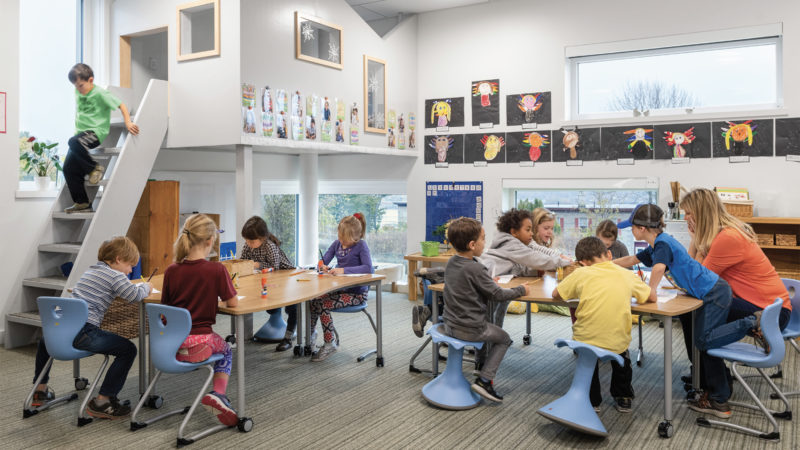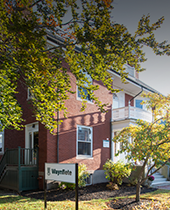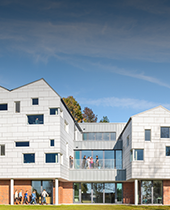8 Essential Building Blocks of a Kindergarten Program
By Jess Keenan (K-1 faculty)
After eight years of teaching at Waynflete, I know that kindergarten is not just about getting students ready for “school.” It’s about laying a foundation for a love of learning that students will take with them through the rest of their school years and beyond. Parents are sometimes unsure about which aspects of a kindergarten program are most important. Here are eight essential building blocks of a strong kindergarten to consider when you’re looking for a program that is right for your child.
1. Authentic learning begins with students’ questions
Young children are naturally inquisitive, curious, and eager to make sense of the world around them. What better way to teach them the things they need to know than by bringing the world inside the classroom?
An approach to learning that is teacher-led and driven by student interest can be a powerful platform for learning. When teachers allow the interest and excitement of students to help shape the curriculum, students feel ownership over their learning and are more engaged and invested.
2. Thematic studies bring learning into the “real world”
Thematic studies born out of student interest and guided by teachers allow students to use math, reading, writing, science, and geography in deep investigations of nature and other topics. During a recent study of bees at Waynflete, a visiting beekeeper shared an observation hive, which inspired students to “build” a beehive under our loft and “become” worker bees, queen bees, and beekeepers.
Over the course of the bee study, students learned about geometry (hexagons), life cycles, pollination, communication systems, measuring distance, and the importance of collaboration and teamwork (both in bee colonies and in the classroom!). We also explored big numbers. Our culminating project was to invite the entire Lower School to help us count 80,000 beads to illustrate how many bees might live in just one hive. What an incredible lesson in number sense!
A thematic curriculum not only places learning in the context of the “real world,” it also inspires further student questions and inquiries, which, with teacher guidance, inspires continued learning.
3. Kindergarteners have to play in order to learn
Play is an essential part of cognitive and physical development. It nurtures the imagination and puts children at the center of their own learning. In the classroom, opportunities for students to make choices, play with materials, and interact with each other lead to inventing, storytelling, and role-playing, which are all forms of independent learning. Outdoor play strengthens the body and aids in development of both gross and fine motor skills. Play also provides opportunities for students to practice social interaction with peers as they navigate the complicated transition from parallel to collaborative play.
4. All children learn to read in their own unique way
Sounds, letters, words, rhymes, books, poems, and songs are the building blocks of early literacy. Since every child is a unique learner, a strong reading program should provide many opportunities throughout the day to engage with written and spoken language as well as materials with which to practice skills. Literacy skills—like all others—develop along a range. A dynamic and flexible multiage curriculum that accommodates the needs of both emergent and beginning readers allows for success at every level.
An effective literacy program will also help kindergarteners develop the skills they need to put their thoughts and ideas down on paper. My favorite writing activity at Waynflete is the weekly journal, where students “write” using illustrations, dictation, and their own words, spelled using their knowledge of letters and sounds. In this way, students develop a powerful and independent ability to express their own ideas.
5. Development of math skills should be woven into all aspects of the curriculum
While math lessons and explicit instruction are an important part of learning numeracy, frequent opportunities to play with math materials are also essential. Manipulatives are a crucial entry point to skill development; hands-on exploration allows for practice of concepts such as counting, number sense, sorting, sequencing, patterns, addition, subtraction, and place value.
A strong kindergarten program integrates math into daily routines and real-life applications. During a study of farms, Waynflete students visited a farmers market and set up a market in the classroom where students weighed, measured, and practiced buying and selling produce to each other.
6. Teaching should be differentiated to meet the range of learning styles in the classroom
Since every child is a unique learner, it is important to have a teacher who knows each child well. The developmental range can be broad in kindergarten, so it is essential that materials, books, and lessons accommodate the needs of each child. As a teacher in Waynflete’s multiage kindergarten/first grade program, I am fortunate to experience firsthand the benefits of having a range of abilities in the classroom. Small class size, mixed groupings, and individualized work plans help students build skills at each level, address their strengths and challenges, and set appropriate goals for progress in all areas of work and play.
7. Giving children the freedom to explore extends the natural curiosity they bring to learning
Five- and six-year-olds are curious by nature. Teachers can fuel curiosity by creating opportunities for students to ask questions, make observations, collect data, research information, form hypotheses, estimate and guess, and—yes—make mistakes.
A structured and inviting classroom environment provides multiple opportunities for independent as well as teacher-guided exploration, learning, and play. Exploration of flexible classroom spaces such as a loft, a sensory table, a conservatory, an art area, and a block center gives students a range of experiences ranging from play to purposeful investigation. Playful exploration is at the heart of all learning.
8. Children do best when social-emotional support is part of the curriculum
Nurturing students’ social and emotional well-being is as important a preparation for learning as is instruction in early reading, writing, and math. For many students, kindergarten may be the first time they’ve had to navigate the dynamics of a large group of peers. Students need guidance in exploring the social realm—learning how to lead, collaborate, compromise, and problem-solve in a safe and supportive environment. In our classroom, the social curriculum is woven throughout our day, shaped by our understanding of individual students, the challenges of each age group, and our guiding principles: take care of yourself, take care of others, and take care of the environment.
At Waynflete, we hope that in addition to building social character, each child will develop a sense of belonging, responsibility toward others, and respect for their own unique qualities. Strong relationships between teachers and students, and their families, are necessary components of this work.



